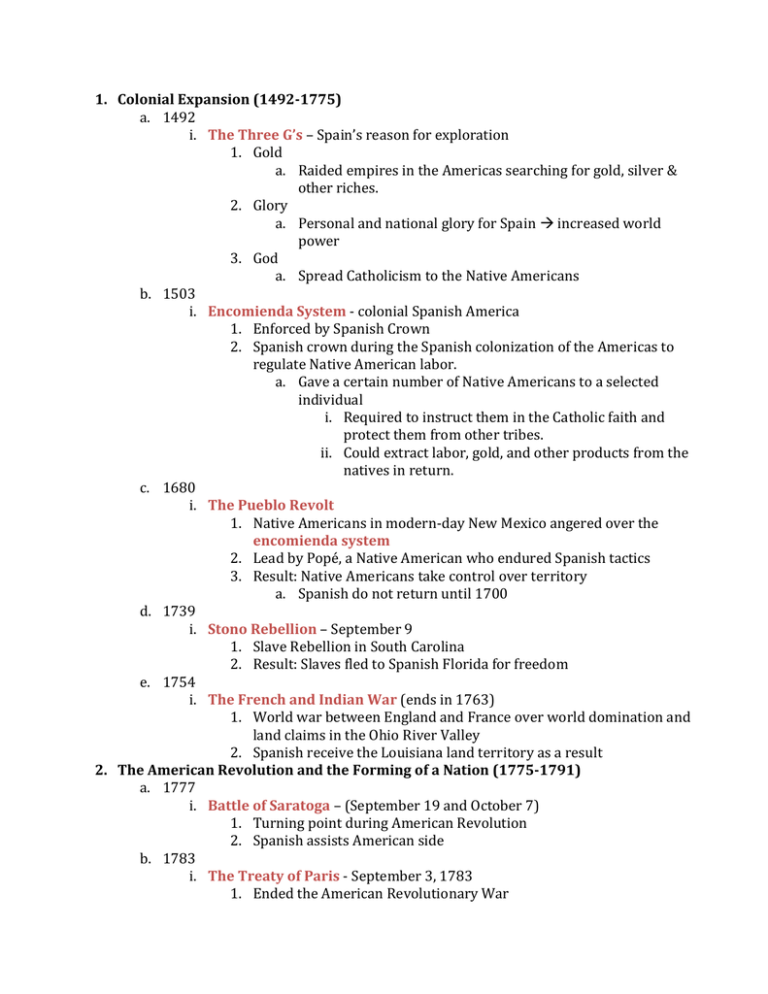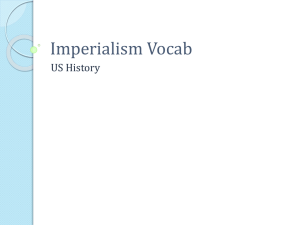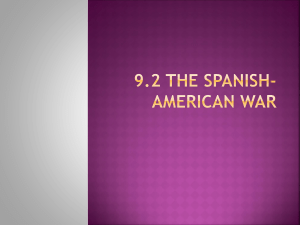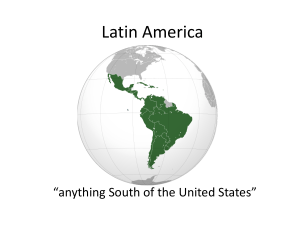Colonial Expansion (1492-1775) 1492 The Three G's – Spain's
advertisement

1. Colonial Expansion (1492-1775) a. 1492 i. The Three G’s – Spain’s reason for exploration 1. Gold a. Raided empires in the Americas searching for gold, silver & other riches. 2. Glory a. Personal and national glory for Spain increased world power 3. God a. Spread Catholicism to the Native Americans b. 1503 i. Encomienda System - colonial Spanish America 1. Enforced by Spanish Crown 2. Spanish crown during the Spanish colonization of the Americas to regulate Native American labor. a. Gave a certain number of Native Americans to a selected individual i. Required to instruct them in the Catholic faith and protect them from other tribes. ii. Could extract labor, gold, and other products from the natives in return. c. 1680 i. The Pueblo Revolt 1. Native Americans in modern-day New Mexico angered over the encomienda system 2. Lead by Popé, a Native American who endured Spanish tactics 3. Result: Native Americans take control over territory a. Spanish do not return until 1700 d. 1739 i. Stono Rebellion – September 9 1. Slave Rebellion in South Carolina 2. Result: Slaves fled to Spanish Florida for freedom e. 1754 i. The French and Indian War (ends in 1763) 1. World war between England and France over world domination and land claims in the Ohio River Valley 2. Spanish receive the Louisiana land territory as a result 2. The American Revolution and the Forming of a Nation (1775-1791) a. 1777 i. Battle of Saratoga – (September 19 and October 7) 1. Turning point during American Revolution 2. Spanish assists American side b. 1783 i. The Treaty of Paris - September 3, 1783 1. Ended the American Revolutionary War 2. Spain received East and West Florida under the separate AngloSpanish peace agreement c. 1790 i. Nationalization Act of 1700 1. Restricted the process of becoming an American citizen a. Only for “free white persons” i. Excludes Asians later on 3. The Federalist Era, Jeffersonian Democracy, and the Market Revolution (17911824) a. 1795 i. Pinckney's Treaty - October 27 1. Between Spain and the United States a. Resolved disputed territories b. Granted American ships the right to free navigation of the Mississippi River c. Duty-free transport through the Spanish port of New Orleans b. 1819 i. Adams–Onís Treaty – under John Adams 1. Between Spain and the United States 2. Florida given to the U.S. 3. Set clear boundary between the U.S. and New Spain (now Mexico) c. 1823 i. The Monroe Doctrine - December 2 1. The U.S. would suppress and intervene if European nations tried to colonize land or interfere with Latin American nations. 4. Jacksonian America (1824-1842) a. 1836 i. Republic of Texas – (ends in 1846) 1. Independence from Mexico 2. Land disputes with Southern Mexico boarders a. Leads to Mexican-American War 5. The Coming of the Civil War, The War, and Reconstruction (1842- 1877) a. 1846 i. The Mexican-American War (April 25, 1846 – February 2, 1848) 1. Conflict after United States’ annexation of Texas (April 12, 1844) 2. Mexico still considers Texas part of its territory 3. United States wins a. Gains land from Texas to California (Treaty of Guadalupe) b. 1848 i. Treaty of Guadalupe – February 2 1. Ends the Mexican-American War 2. United States acquired more than 500,000 square miles of valuable territory and emerged as a world power in the late nineteenth century. 3. Promised U.S. citizenship to former Mexican citizens living in those territories c. 1854 i. Ostend Manifesto 1. Document between United States and Spain 2. United States purchases Cuba from Spain a. Implies that the U.S. will declare war if Spain refused. ii. California Gold Rush – (ends in 1855) 1. Gold is found in California 2. An influx of Latin Americans came to California in 1848 3. Immigrants from China began coming in 1849 d. 1863 i. The Transcontinental Railroads 1. Connected the Western Frontier with the East Coast 2. Many Mexican and Chinese immigrants aided the building of these railroads. ii. Chinatowns 1. Chinese immigrants after the building of the Transcontinental Railroads 2. Created communities in different large cities a. Share similar interests and culture e. 1865 i. Klu Klux Klan – (1865-1870s, 1915-1944, 1946-current) 1. Extremist group originating in the South 2. Anti-Immigration f. 1868 i. Burlingame Treaty 1. Between the United States and China 2. Gave Chinese-American immigrants basic rights given by the Constitution 3. Encouraged Chinese immigration 6. The Gilded Age (1877-1889) a. 1877 i. Workingmen's Party of California in 1877 1. Established in San Francisco 2. Formed in response to high unemployment 3. Anti-Chinese campaign – “The Chinese must go!” a. Harmful to the welfare of the state took all the labor jobs b. 1882 i. The Chinese Exclusion Act of 1882 - May 6 1. Reversed Burlingame Treaty 2. Allowed the U.S. to suspend Chinese immigration, a ban that was intended to last 10 years. c. 1898 i. Spanish American War – April 25, 1898 – August 12, 1898 1. The result of American intervention in the Cuban War of Independence. 2. Ended with Treaty of Paris (1898) a. Spain surrendered control of Cuba and ceding Puerto Rico, parts of the West Indies, Guam, and the Philippines to the United States. b. Payment of $20 million to Spain by the United States 3. Effect: Ended Spanish presence in America and the Pacific Ocean ii. American Anti-Imperialist League 1. Against the annexation of the Philippines 2. Imperialism violated the fundamental principle of the republican government a. Violated the idea of “consent of the governed” 3. Supported non-intervention and self-government 7. The Progressive Era (1889-1917) a. 1899 i. Philippine–American War 1. Armed conflict between the United States and Filipino revolutionaries. a. First Philippine Republic wanted to gain independence following annexation by the United States. 2. United States victory a. The Philippines becomes a territory of the United States b. 1901 i. Platt Amendment 1. After the Spanish American War 2. Legislation that severely restricted Cuba's sovereignty and gave the US the right to intervene if Cuba got into trouble ii. Insular Cases - till 1979 1. U.S. Supreme Court cases 2. Unclear status of the territories acquired by the U.S. during the Spanish American War 3. Debate whether or not the U.S. Constitution covered these areas a. U.S. Citizenship for these areas was debated c. 1904 i. Roosevelt’s Corollary - December 1. U.S. will aid any Latin American nation experiencing financial trouble 2. The Good Neighbor Policy d. 1907 i. Gentleman’s Agreement 1. Created by Theodore Roosevelt 2. Informal agreement between the San Francisco School Board and the Japanese government e. 1909 i. Taft’s Dollar Diplomacy - under President William Howard Taft 1. To further its aims in Latin America and East Asia through use of its economic power by guaranteeing loans made to foreign countries. f. 1914 i. Panama Canal – (completed in 1977) 1. Construction of canal in Panama with many setbacks (disease, engineering trouble, etc.) 2. Roosevelt raised a fight for Panama to gain independence from Colombia, so he could gain permission to build. a. Panama signs agreement to build in 1903 3. Gunboat diplomacy/Big Stick a. Objectives with obvious displays of military power g. 1917 i. Zimmerman Telegram - March 1. Diplomatic proposal from the German Empire to Mexico to make war against the United States. 2. Anticipation of the resumption of unrestricted submarine warfare by Germany on 1 February a. An attempt to draw the neutral U.S. into war on the side of the Allies. 3. Intercepted by British intelligence 4. Mexico rejected unable to compare to the United States’ army 8. World War I and the Roaring 20's (1917-1929) a. 1924 i. The National Origins Act of 1924 - May 26 1. United States federal law that limited the annual number of immigrants who could be admitted from any country to 2% of the number of people from that country who were already living in the United States in 1890 2. Effected Asian-Americans (Asian Exclusion Act) 3. Did not effect Mexicans and Puerto Ricans a. Increased the number of immigrants to United States they were not restricted by the immigration acts. 9. The Great Depression and the New Deals(1929-1938) a. 1933 i. Good Neighbor Policy – under FDR’s presidency 1. Non-intervention and non-interference in the domestic affairs of Latin America. 2. Hope: create new economic opportunities in the form of reciprocal trade agreements and reassert the influence of the United States in Latin America 3. Result a. No more Platt Amendment b. U.S. removal of marines in Haiti and Nicaragua c. Allowed Japanese students to attend public school if the Japanese government would help stop the increasing number of immigrants coming to California. 10. World War II and the Start of the Cold War(1938-1953) a. 1942 i. Japanese American Internment 1. After Japanese attack on Pearl Harbor 2. Increased fear of Japanese espionage 3. U.S. Government ordered all Japanese Americans living in the West to go to camps. a. 62% were American citizens ii. Executive Order 9066 – February 19th 1. Franklin D. Roosevelt a. Authorized the Secretary of War create military zones for the deportation of Japanese Americans to internment camps. iii. Fifth Column 1. Definition – a group of people planning to undermine a larger group (i.e. a Nation) 2. Japanese-Americans were given this name during WW2 iv. Bracero Program – August 1942 – 1967 1. Diplomatic agreement between Mexico and the United States 2. Importation of temporary contract laborers from Mexico to the United States. b. 1943 i. Zoot Suit Riots - June 1. Suits worn by Mexican-American street gangs a. Caused resentment of the white middle class 2. Policeman raided Hispanic communities in the West a. Outfit is outlawed c. 1944 i. Korematsu v. United States 1. U.S Supreme Court Case a. The constitutionality of Executive Order 9066 2. Korematsu refused to relocate 3. Court sided with the government deemed it to be constitutional under public safety over citizen rights 11. The Civil Rights Movement & The Great Society(1953-1966) a. 1959 i. Castro and Cuba – 1959 1. Fidel Castro overthrows Cuban dictator (Batista) a. Cuban exiles living in America rejoice 2. Castro nationalized American owned businesses a. Communist State 3. Eisenhower creates plan to invade Cuba and overthrow Castro b. 1961 i. The Alliance of Progress – March 1. “Latin American Marshall Plan” 2. Initiated by U.S. President John F. Kennedy in 1961 aimed to establish economic cooperation between the U.S. and Latin America. 3. Political and material freedom ii. Bay of Pigs – April 1. Kennedy uses CIA forces to land in Cuba a. Immediately defeated by armed Cubans upon arrival 2. Result: Invasion is a failure 3. Embarrassment for United States government c. 1962 i. The Cuban Missile Crisis – October 1. Castro and Khrushchev threatened U.S. security 2. U.S. Spy planes discovered nuclear missile building sites in Cuba. a. These missiles were far range, making every place in North American vulnerable. 3. Kennedy orders removal of missiles Castro and Khrushchev refuse a. Kennedy resorts to naval blockade 4. Result: Missiles are removed, U.S. has to promise to never invade Cuba again and remove its missiles from Turkey




